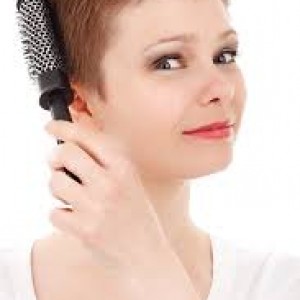
Hair growth is cyclical and occurs in three concurrent phases: anagen (growth), catagen (cessation), and telogen (rest). The anagen growth phase is the longest out of the three phases, lasting an average of 2-6 years. At any given time, 85-90% of hair is in the anagen phase. During this phase, the matrix cells of the hair follicle are rapidly dividing and hair is growing at an average rate of 1 cm every 28 days.
Anagen effluvium is the loss of anagen-phase hairs, typically caused by chemotherapy or radiation therapy. Approximately 65% of individuals undergoing chemotherapy will experience hair loss;1 however, the severity of hair loss varies from person to person, depending on the chemotherapeutic agent and the duration of treatment. Hair loss can begin within days or weeks after the start of treatment, starting from the crown and sides of the head, usually as a result of increased friction during sleep and wearing head coverings. In the beginning, hair loss may be patchy, and hair loss continues for the duration of chemotherapy. Nevertheless, this type of hair loss is usually completely reversible as only the multiplying cells are affected by chemotherapy (the inactive stem cells of hair follicles are not affected). Most patients will experience hair regrowth 1 to 3 months after cessation of chemotherapy. In 60% of the cases, this regrowth can be of a different texture, thickness, color, or waviness.2
One medical approach used to minimize chemotherapy induced hair loss is scalp cooling, although the benefits of this technique are not yet clear.3 Topical 2% minoxidil (Rogaine®) has also been used in chemotherapy induced hair loss.1 Applying minoxidil to the scalp 24 hours before treatment and continuing use throughout therapy and up to 4 months following therapy,4 has been shown to lengthen the time for maximal hair loss during chemotherapy, and shorten time to regrowth following therapy.5
Since chemotherapy-induced hair loss cannot be prevented, appropriate hair and scalp care along with temporarily wearing of a hair-piece may be the most effective coping strategy.4
Article by: Dr. M. Cernea, Mediprobe Research Inc.
References
- Trüeb RM. Chemotherapy-induced alopecia.Semin Cutan Med Surg 2009;28(1):11-14.
- Kanwar, AJ and Narang, T. Anagen effluvium. Indian J Dermatol Venereol Leprol 2013. 79(5): 604-12.
- Grevelman EG, Breed PM. Prevention of chemotherapy-induced hair loss by scalp cooling. Ann Oncol 2005; 16(3):352-358.
- A guide to chemotherapy. American Cancer Society website. www.cancer.org/treatment/treatmentsandsideeffects/treatmenttypes/chemotherapy/understandingchemotherapyaguideforpatientsandfamilies/understanding-chemotherapy-common-side-effects-hair-loss.
- Duvic M, Lemak NA, Valero V, et al. A randomized trial of minoxidil in chemotherapy-induced alopecia. J Am Acad Dermatol 1996; 35:74–78.












